Did you know that one-third of people over the age of 65 years fall at least once per year? And about 50% of them will suffer recurrent falls (Masud and Morris, 2001). As a health and exercise professional, incorporating exercises into your clients’ programs that can aid in fall prevention is essential.
Based on a presentation delivered by Dr. Chris Thompson, an associate professor of kinesiology at the University of San Francisco, Here are a few more sobering statistics that support the need for specialized strength training:
• Older adults experience approximately 400,000 fractures per year due to falls.
• More than 20% of hip fractures result in death within one year following the injury.
• By 2030, 25% of Americans will be older than 65 years.
Even among relatively fit and healthy elderly individuals, falls are common (Stel et al. 2003a), and the consequences of falls are known to contribute substantially to the prevalence of health problems (Lord and Dayhew, 2001), health care costs (Stevens et al., 2006) and to lowered quality of life (Cumming et al., 2000). Additionally, confidence and fear of falling have been found to be key contributors to reoccurring falls (Landers et al., 2016).
When working with active agers, the goal is to develop programs that boost confidence, while progressing clients’ movement patterns to address any losses in strength, balance, somatic senses and power. As a result, these physical improvements may lead to an enhanced quality of life.
Ideally, training for strength and balance should begin before the risk of falls begins to increase. For this reason, strength and balance training is important for everyone—not just older adults.
How to Use the TRX to Increase Strength and Balance in Active Agers
The TRX is a convenient and accessible method of training, in part because it can be used just about anywhere there is an anchor. The straps of the TRX offer “real-time” feedback by providing a proprioceptively rich environment for the participant, while also offering a sense of safety and assurance, which can help increase the exerciser’s confidence. By holding on to the handles when performing movements, clients who struggle with balance and/or single-leg strength may feel more at ease, which will allow the for a more productive learning experience. And, because it is anchored to a single point, the TRX also makes it easy to spot imbalances and compensations as the client executes the exercise.
Here are a few TRX exercises to incorporate into your clients’ programs. These exercises challenge balance and build strength, dynamic movement and mobility. Additionally, these exercises also target the core, which is essential to maintaining mobility and reducing one’s risk of injury.
The Exercises
Perform each of the following exercises only as long as the movement stays strong and is not compromised. For active agers, have them perform 5-6 reps, rest a couple of minutes and repeat for 4-6 rounds.
TRX March: Adjust the length on the straps to between mid-length (the hardware that changes the length is moved to the center of the straps) and mid-calf (the hardware is adjusted so that the foot cradles end at the middle of the calf). Stand facing the anchor point, centered. With arms extended, in line with the shoulders, press down on the handles to create tension throughout the body. Alternate lifting one leg while driving the opposite leg into the floor. Maintain tension on the straps throughout the movement (no sagging). As clients progress in confidence and greater range of motion, have them begin to play with head motion, looking right and left, slowly, after each step and then back to center. As stability increases, move clients to face away from anchor and practice the same moves. Play with tempo and pausing the patterns.
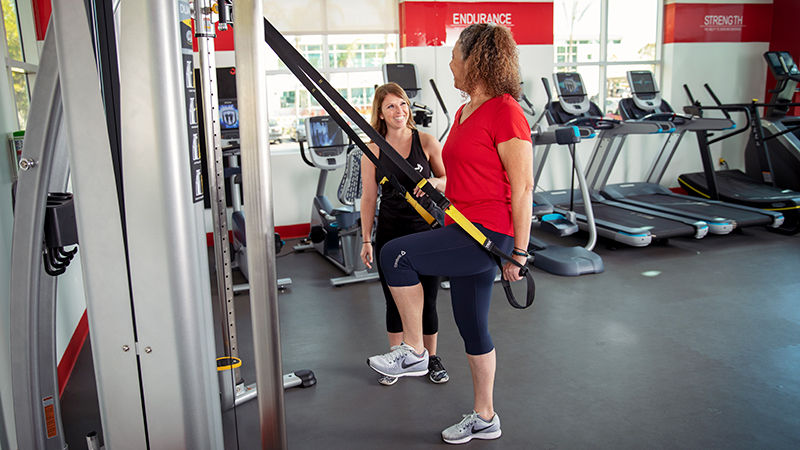
TRX Squat: Adjust the length to mid-length. Stand facing the anchor point, with feet hip-width apart or in a position that creates the most freedom of movement in the hips. Holding on to the handles, elbows under the shoulders and palms facing one another, have the client feel his or her torso, creating some tension in the trunk. Cue the client to lower the sacrum toward the floor and then push the floor away to stand fully, working toward full hip extension. Incorporate holds, reduce the pace on the eccentric portion of the movement, or add a powerful burst on the concentric portion of the movement. You can also change the head movement (e.g., look up, to the right, up and left) to challenge and work with the vestibular system. (A chair can be added as a tactile cue and can assist with range-of-motion limitations until they are reduced).
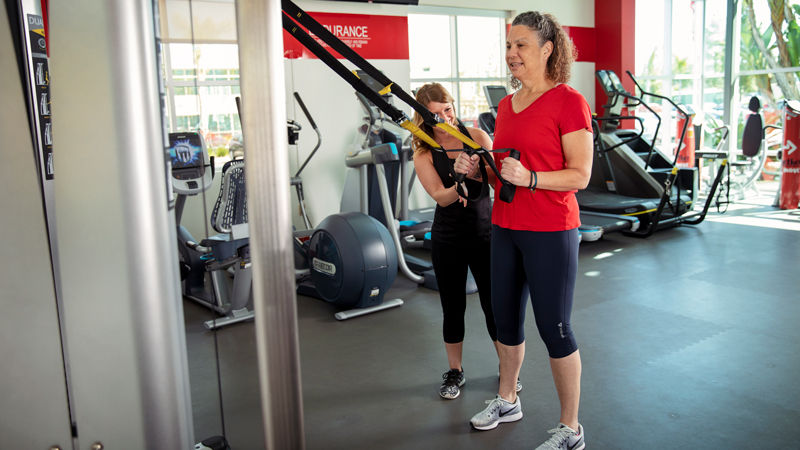
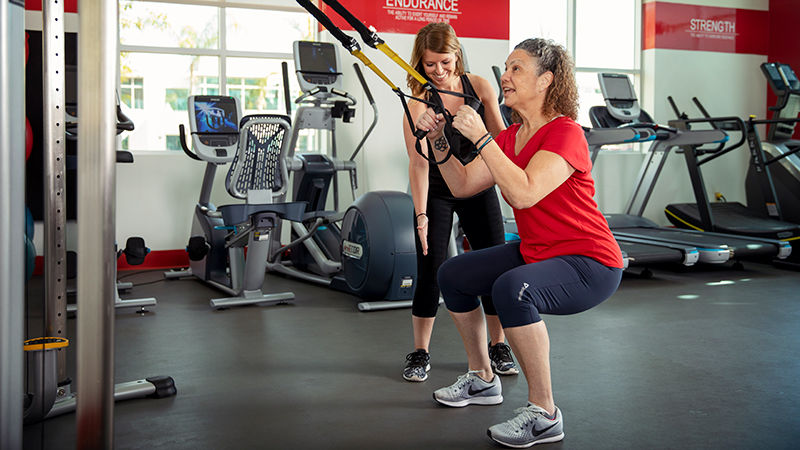
TRX Single Leg With Kick Stand: Adjust the straps to mid-length and stand facing the anchor point. Hold on to the handles with the elbows bent and under the shoulders, palms facing one another. Standing on the right leg, lift the left leg to where the load is primarily in the right. Follow the same cues as for the squat. Adding a chair can give the client a goal to work toward while working on single-leg strength and balance. Variations to play with include touching foot of the unloaded leg to the floor to assist with balance. The client also lower with both feet on the floor and then rise while standing on one. Play with tempo, eye targets and foot positions, as stability and strength increase, and be sure to alternate sides.
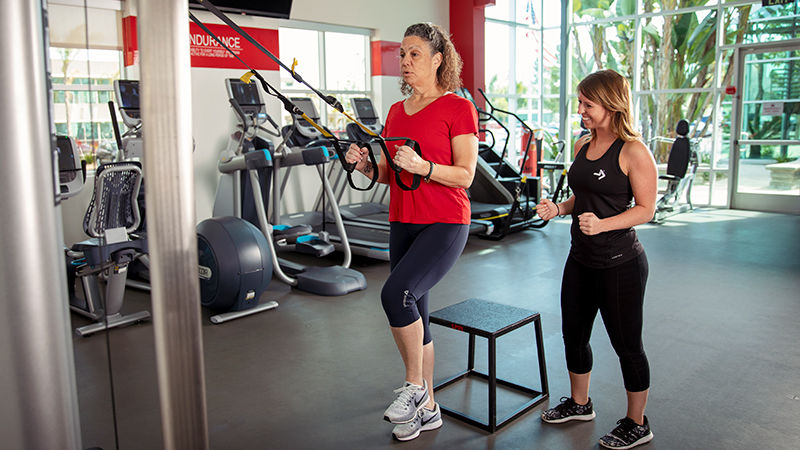
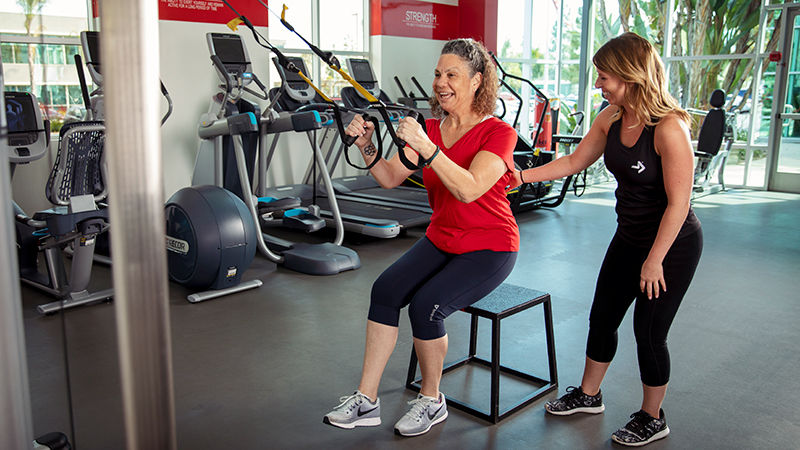
TRX Single-leg Stand With Rotation: Stand facing the anchor point with the straps at mid-length. Hold on to handles, with the elbows under the shoulders and the palms facing one another. Standing on the right leg, flex and lift the left knee. Keep driving the right leg into the floor, but be mindful to avoid locking out the knees. With the knee flexed, begin to circle the leg to the side, moving through a full circle, completing the rotation. Switch directions and return the same way; alternate sides.
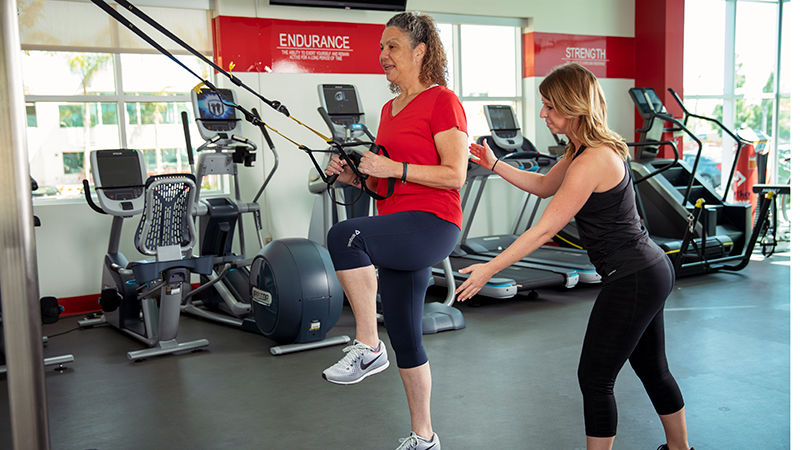
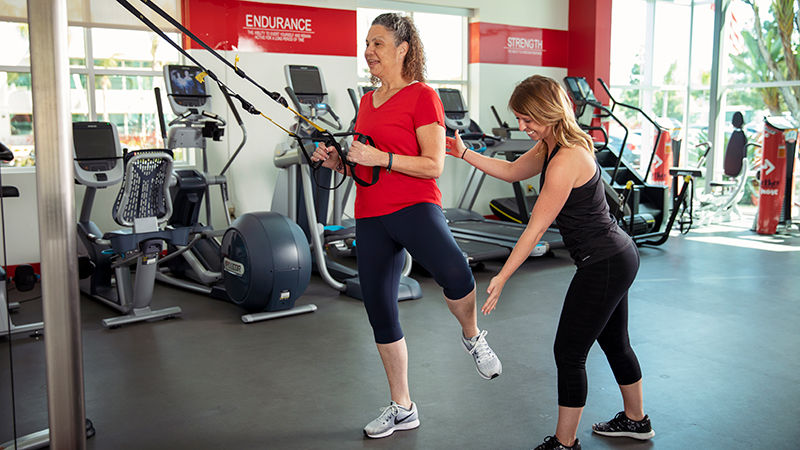
TRX Step Side Lunge: Adjust the straps to mid-length and stand facing the anchor point. Hold the handles with the elbows bent and under the shoulders. Try to keep the feet facing forward while stepping to the right and back to center, alternating sides.
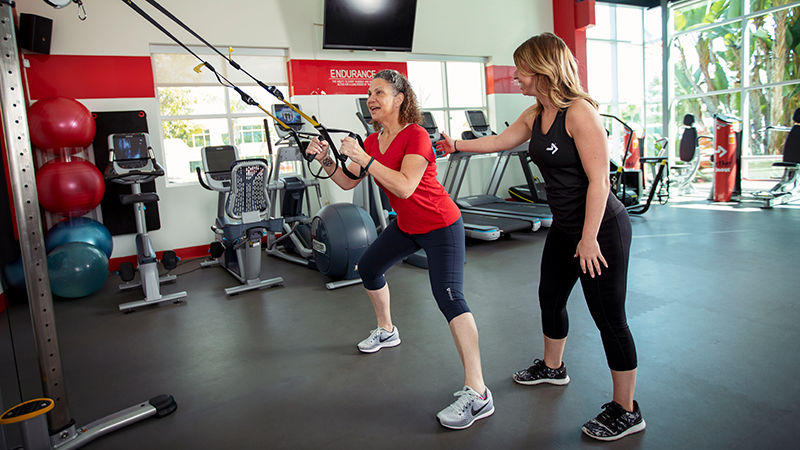
TRX Row: Adjust the straps to shortened and stand facing the anchor point with feet hip-width apart or wider. Hold on to the handles with the elbows bent and the palms facing one another. Maintaining tension with the straps, walk toward the anchor only as far as the load can be managed while keeping tension in the torso. Lower toward the floor and pull back toward the anchor point. The closer the feet are to the anchor, the heavier the load becomes.
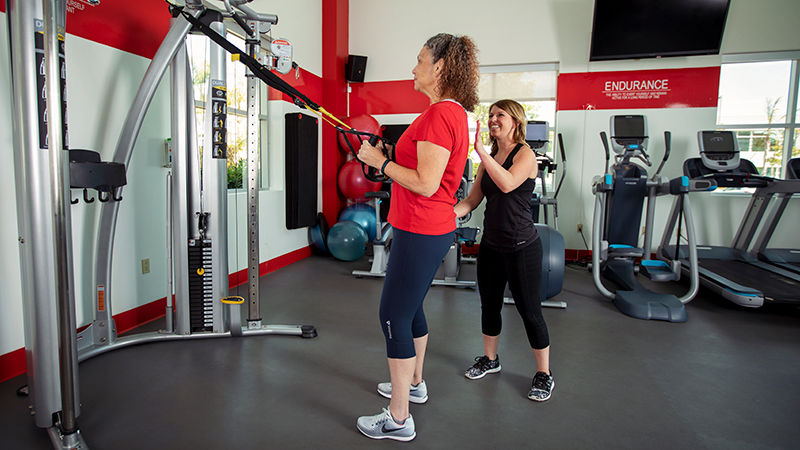
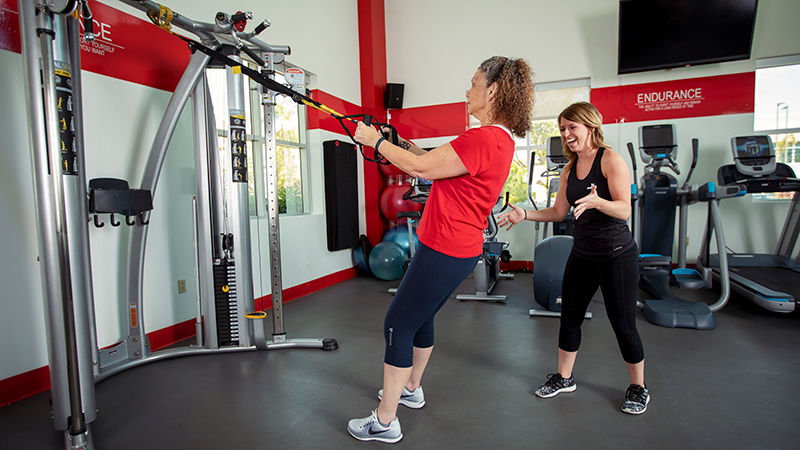
TRX Squat/Row: Combine the two movements to create a more complex movement pattern.
TRX Forward Step With Alternating Arms: Adjust the straps to mid-length and stand facing away from the anchor point, centered. Hold the handles so that the arms are extended in front with the wrists in line with the shoulders. Step forward with the right leg and simultaneously raise the left arm toward 10:00 and the right arm toward 4:00. Return to the starting position and repeat on the other side (left leg forward, arms at 2:00 and 6:00. Vary the movement by bringing both arms out to the side in a “T” position or bring both arms overhead. Play with tempo and holds, keeping tension in the straps at all times.
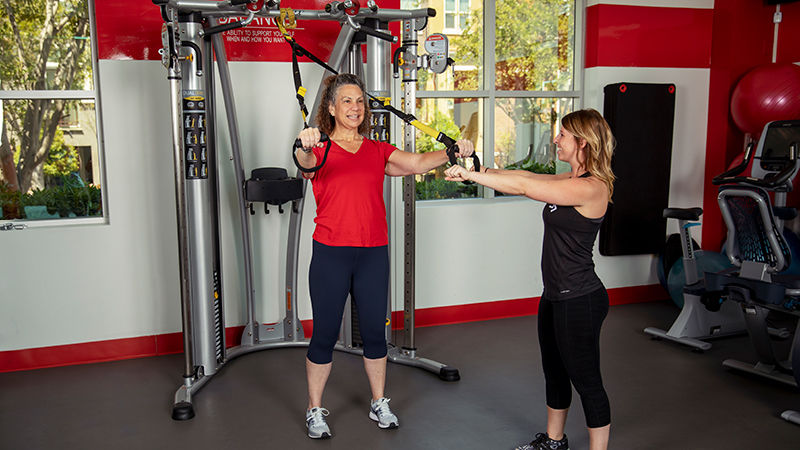
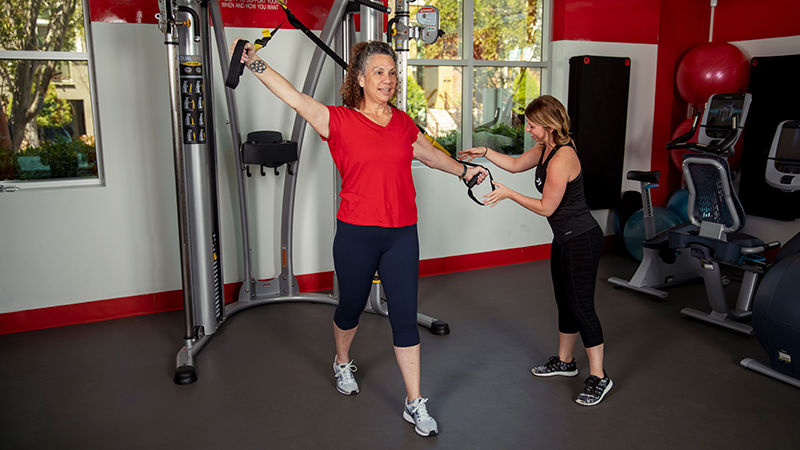
TRX Stand With Rotation and Breath: Adjust straps to mid-length, in single handle mode. Stand facing the anchor point. Feet hip width or wider. Holding on to the handle with left hand, both arms extended towards anchor. Inhale and as you exhale, begin to open right extended arm/hand, towards the floor and hold as you breathe. With each exhale, continue to rotate towards the floor, keeping hips facing the anchor. Alternate sides.
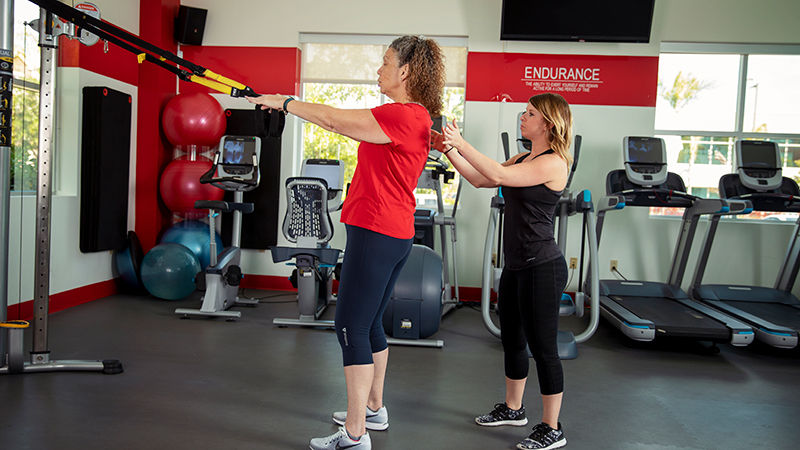
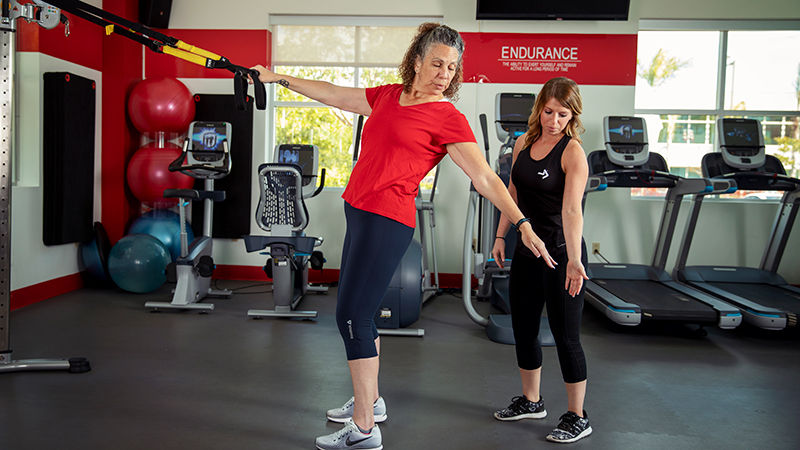
Want to broaden your scope and learn how to effectively work with active agers by helping them move more efficiently? Become an ACE Senior Fitness Specialist.
References
Cumming, R.G. et al. (2000). Prospective study of the impact of fear of falling on activities of daily living, SF-36 scores, and nursing home admission. The Journals of Gerontology: Series A, Biological Sciences and Medical Sciences, 55, 5, M299−305.
Landers, M.R. et al. (2016). Balance confidence and fear of falling avoidance behavior are most predictive of falling in older adults: Prospective analysis. Physical Therapy, 96, 4, 433−442.
Lord, S.R. and Dayhew, J. (2001). Visual risk factors for falls in older people. Journal of the American Geriatric Society, 49, 5, 508−515.
Masud, T. and Morris, R.O. (2001). Epidemiology of falls. Age Ageing, 30, Supplement 4, 3−7.
Stel, V.S. et al. (2003). Balance and mobility performance as treatable risk factors for recurrent falling in older persons. Journal of Clinical Epidemiology, 56, 7, 659−668.
Stevens, J.A. et al. (2006). The costs of fatal and non-fatal falls among older adults. Injury Prevention, 12, 5, 290−295.




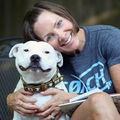 by
by 


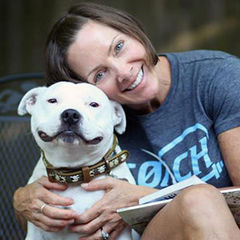


 by
by